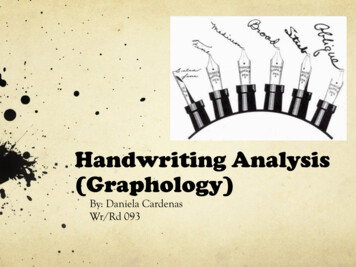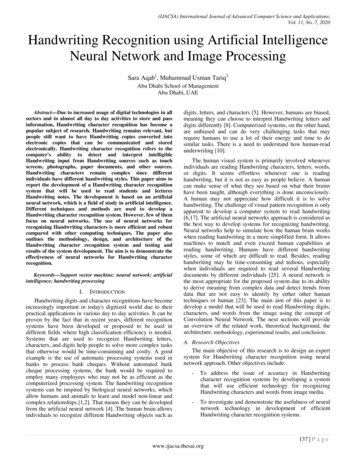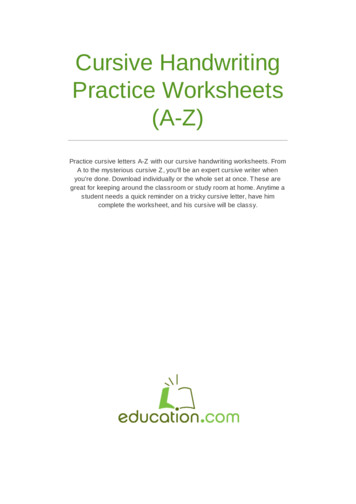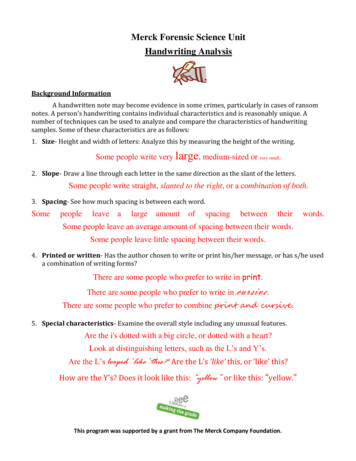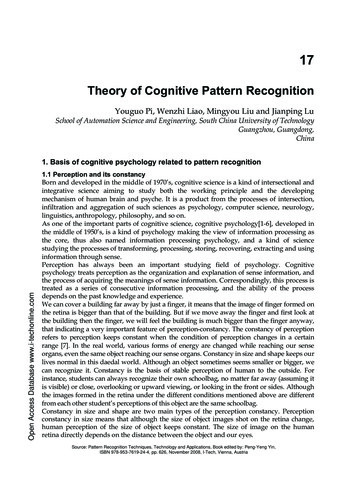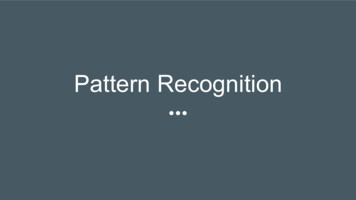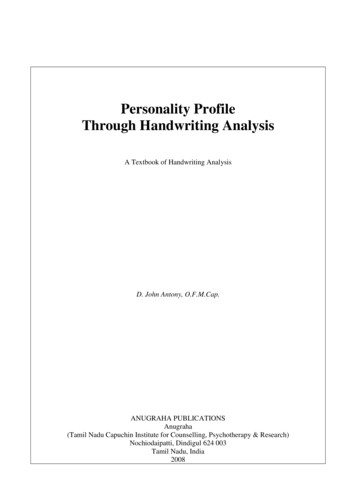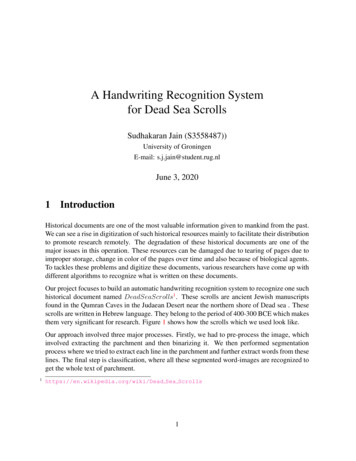
Transcription
A Handwriting Recognition Systemfor Dead Sea ScrollsSudhakaran Jain (S3558487))University of GroningenE-mail: s.j.jain@student.rug.nlJune 3, 20201IntroductionHistorical documents are one of the most valuable information given to mankind from the past.We can see a rise in digitization of such historical resources mainly to facilitate their distributionto promote research remotely. The degradation of these historical documents are one of themajor issues in this operation. These resources can be damaged due to tearing of pages due toimproper storage, change in color of the pages over time and also because of biological agents.To tackles these problems and digitize these documents, various researchers have come up withdifferent algorithms to recognize what is written on these documents.Our project focuses to build an automatic handwriting recognition system to recognize one suchhistorical document named DeadSeaScrolls1 . These scrolls are ancient Jewish manuscriptsfound in the Qumran Caves in the Judaean Desert near the northern shore of Dead sea . Thesescrolls are written in Hebrew language. They belong to the period of 400-300 BCE which makesthem very significant for research. Figure 1 shows how the scrolls which we used look like.Our approach involved three major processes. Firstly, we had to pre-process the image, whichinvolved extracting the parchment and then binarizing it. We then performed segmentationprocess where we tried to extract each line in the parchment and further extract words from theselines. The final step is classification, where all these segmented word-images are recognized toget the whole text of parchment.1https://en.wikipedia.org/wiki/Dead Sea Scrolls1
2MethodsIn this section, first, we will give the explanation of our pipeline of the system about how itworks overall, including its input, output, components and their functions. Then, we will talkabout how these components are implemented in details.2.1System PipelineThe system processes goal images one by one automatically. The input of one assignment ofthis system is a grey level photo of the Dead Sea Scrolls in a good quality, as shown in Fig 1.Figure 1: The example picture of the Dead Sea Scrolls as an inputSince there is redundant information on the image, we preprocessed it to isolate the content ofour interest which is the parchment. After the isolation of our interested area, we then detectedand segmented the text lines on it; for each line, we also segmented it in word levels. Theimage fragments of words were passed to the classification step. In the classification step,we used sliding window approach to ensure the classification work is done on character level.Each cropped image obtained from the sliding window was passed to classifier for characterrecognition. Finally, the classified results were saved in a .txt file in the same order as the inputimage. Note the text of the output file should be read from right to the left, since that is howHebrew is written. Fig 2 visualizes this system pipeline as an overview.2
Figure 2: Pipeline of the handwriting recognition system2.22.2.1Pre-processingImage processing and information extractionThere are five main steps of this part as shown in Fig 3.Figure 3: Five main steps of image processing and information extraction. From left to righteach image represents: Step 1 - using Otsu binarization on the example image; Step 2 - usingSauvola binarization on the example image; Step 3 - finding the biggest component from theOtsu binarized image; Step 4 - whitening the largest component found in previous step, theninverting its black and white; Step 5 - masking operation of the Step 2 image and the the lowersub image of the Step 4 image.3
Otsu Binarization Binarization of an image refers that for the pixels of an image, if a pixel’svalue is greater than a certain threshold, then it is set to 1 as a foreground pixel, if not it is set to0 as a background pixel. Determine of the threshold is critical. The threshold could be globalas how Otsu algorithm works (Otsu, 1979). Otsu algorithm calculates the optimal threshold forseparating the foreground pixels and the background pixels, such that the variance within oneclass is minimal, and the variance between two classes is maximal. In our practical implementation, we applied the library thresholdo tsu 2 from the open source module skimage.f ilters3 .Sauvola Binarization Sauvola algorithm calculates the threshold for a certain pixel dynamically. Sauvola algorithm centers on the current pixel, calculates its binarization threshold basedon the grey level mean and standard variance of its neighborhood pixels within a certain sizedwindow (Sauvola, Seppänen, Haapakoski, & Pietikäinen, 1997). In our practical implementation, we applied the library threshold sauvola 4 from the same module.Connected Component A Connected Component generally refers to an image region composed of foreground pixel points having the same pixel value and adjacent in the image. Weneed to traverse the pixel matrix of one image. For one pixel, we explore its adjacent pixels (4directions in our case but could also be 8 directions), to see if they have same values with it:if so, we labeled them as the same with the current pixel; if not, we labeled them differently(Suzuki, Horiba, & Sugie, 2003). In our practical implementation, we imported the libraryconnectedComponentsW ithStats from the module OpenCV 5 , which could also return thetotal area (in pixels) of a connected component.Whitening and BW Invertion We set the value of the pixels within the area of the biggestconnected component as white (background is black), then inverted its white part into black andvice versa, for the convenience of using is as a mask.Masking We compared the pixels of the image matrix one by one of the Sauvola binarizedimage with the BW inverted mask image from former step. If the pixel in the mask image iswhite, then we set the pixel with the same location in the Sauvola binarized image into whitetoo. Thus we deleted the noise in the background while kept the text information of our /skimage.filters.html#skimage.filters.threshold skimage.filters.html#skimage.filters.threshold gproc/doc/structural analysis andshape descriptors.html4
Figure 4: Isolated image rotated by-2 degree Figure 5: Histogram representing the reducedimage matrix with -2 rotated degreeFigure 6: Isolated image rotated by 4 degree Figure 7: Histogram representing the reducedimage matrix with 4 rotated degree2.2.2Geometric correctionThough we believe the image was taken as carefully as it can be, tilting of the area of interestcould still be a problem sometimes. Thus we needed to revise it into an optimal degree. Wefirstly rotated the image by certain degrees, for example as shown in Fig 4 and Fig 6 - rotatedby -2 degrees and 4 degrees. There are two major steps to find the optimal rotation degree.Reduce Operation For each image with one specific rotating degree, we reduced the matrixof the image to a 1D vertical vector by accumulating each row. Thus, for one element of thisvector, its value can be used to represent the text information load, and its index means whichrow it was summed from. Finally, we converted the values (we divided them by the length ofthe row of the image matrix to use it as a mean) and their indices of the reduced vector into ahistogram. Fig 5 and Fig 7 are the corresponding histograms of the text images in Fig 4 andFig 6 respectively. We used the library reduce from OpenCV 6 in practical implementation.In Fig 5 and 7, the horizontal axis represents the row index and the vertical axis represents thevalue of the reduced oc/operations on arrays.html#reduce5
Peak Detection It is clear to see the pointed strips (look from up to down) indicate the areaswith dense black pixels. Since we did grey level conversion for the convenience of furtherclassification, the white value here is 255 instead of 1. Looking at the histograms we can say thatmore the consistency of text load, more seperated are the stripes and thus better distinguishedare the lines. We can see intuitively, by the comparing Fig 4 to Fig 7. We used an opensource library peakdetect 7 in our practical implementation: this method, first labels the wavepoints by looking into the pixel values; then it traverses the wave points determining the peaksaccording to their ’height’ represented by the row index; it also has a parameter lookaheadas the distance to look ahead from a peak candidate to determine if it is the actual peak or just ajitter. Here we set the lookahead 50, as it is the approximate height of a character. For eachrotated image, we scored its histogram in this way: we summed the intervals of a pair of highestpeak and lowest peak with same list index; when the score is the highest, the correspondingrotation degree is the optimal.2.32.3.1SegmentationSegmentation of linesThe segmentation of lines was implemented as a follow-up of to the optimal degree rotation.Here, we looked for the peaks of its histogram to segment the image into fragments each containing one line. Take Fig 5 as an example, where we can see that the peaks are distinctlyseperated from one another. Here, the 4th peak around 2000 horizontal coordinate, which is thehighest, indeed represents the 4th line of Fig 4 being the longest. We used the locations of thesepeaks and extracted the pieces from the image.2.3.2Segmentation of wordsThe segmentation of words were implemented with the same approach as the segmentation oflines. There are three major differences compared with line segmentation:1) the image matrix was reduced to a row vector first;2) we set lookahead 30 here as it was the approximate length of one character;3) since there are also blanks between and inside the characters, that could cause peaks on thehistogram not as high as 255. Since we only want to segment the line into words, we increasedthe value threshold of a peak to be 255 to prevent the problem of over /61264506
2.42.4.1ClassificationImplementation of ClassifierThe Hebrew language consists of 27 characters in total. So to recognize the characters in thesegmented word images, we implemented a Convolutional Neural Network(CNN) (LeCun, Bottou, Bengio, & Haffner, 1998) which acts as a classifier with 27 classes. The architecture of thisCNN is as shown in the Figure 8.Figure 8: Architecture of our Convolutional Neural NetworkWe were provided with a dataset for training this CNN which had varying number of samplesfor each character along with their labels. Also, each sample image was of different resolution.After inspecting these images manually, we realized that all these images had resolution around45x35x3. Another, careful observation we obtained was the number of channels present in thesesample images. These images had 3 channels even though they looked like binary images. But,our preprocessing step converted the scroll images to binary which have single channel. So,in order to train the CNN to recognize characters in these binary images, it has to be trainedusing sample images which are also binary having single channel. Considering all these aboveaspects, we converted all the samples in the given dataset to binary images and resized themto resolution of 45x35x1. Hence, this became the input resolution of our CNN as depicted inFigure 8.The above modified dataset was divided into two parts namely training and test set. The CNNwas trained on the training set and the test set was used for evaluating the accuracy. The trainingis performed by providing the character images of training set as input on one end and respectiveclass labels as output on the other end. The test set is never used in training and thereforerepresents the unseen data used for evaluating accuracy.The CNN was trained for 100 epochs and the best accuracy obtained on this dataset was around92.5%. We intended to improve this accuracy to achieve better performance. We realized thatthe total size of the dataset was less for training. So, we decided to augment more images. We7
performed this data augmentation using width-shift, height-shift, shearing and zooming. Wedid not use horizontal or vertical flipping for augmenting as not all characters were symmetric.The best accuracy we achieved was 93% after experimenting with many parametric values usedin our data augmentation. Even though the improvement in the accuracy is less, it makes theCNN to generalize more efficiently therefore increasing its robustness.2.4.2Implementation of Sliding WindowAs seen in the above sections, the output of the segmentation process is a list of word imagessegmented from each line in the given scroll image. Each of these word images consist ofmultiple characters on them which need to be further segmented and given to the classifier.To implement this, we came up with the idea of sliding window. Here, we take a window ofparticular shape and size and start sliding over the word image. Each time we slide, we takethe image inside this window and pass it to the classifier for character recognition. It should benoted that this image is resized to the resolution of 45x35x1 before being passed to classifier.The recognized character is then written on the output text file after transcription.After implementing this concept, there were many problems which we faced with respect toperformance. Firstly, we saw few blank images being cropped by the window. After someinspection, we found that even after ’segmentation of words’ procedure was performed, eachword image did have some white spaces on both the ends. This made the window to crop thewhite spaces and send it to classifier. To resolve this issue, we took the average of values ofall the pixels in the cropped image. If this value was greater than a threshold, then we omittedthe image considering it to be a blank white image. The threshold was decided on a trial anderror basis. Secondly, we also found difficulties in deciding the optimal value of step-size forsliding. If it was very low, it would lead to repetitions of cropped images and if it was higher,some characters were omitted from being cropped.2.4.3TranscriptionThe output of the classifier is the string label of character which is predicted. So to write theactual character on the output text file, we had to first convert these labels into their actualcharacters. This was done by implementing a transcription code which writes the respectivecharacters in the file when given character labels.8
3ResultsThe result of the project is a complete handwriting recognition system, designed especially forthe Dead Sea Scrolls. We can run it easily by a couple of instructions 8 . Note that the images tobe recognized should be saved in the input folder under the directory of the system, then afterrunning the instructions, the recognized results would be saved in the output folder as .txt file.We also have three running modes, normal, debug, and fast. In fast mode, the systemwould skip over the intermediary results. The average processing time of one image is about 7to 11 seconds, depending on the runmode and the machine running the program. Following arethe results of each step.Preprocessing The result example of the preprocessing is contained in the Methods section,as shown in Fig 4. Compared with the original image in Fig 1, the information of our interestgot mostly retained. We noticed that it was also slightly rotated to correct the tilted text. Still,a little information was lost during this step, especially around the margins of the scroll image.Also, the noise of the Sauvola binarized image in the background was nicely removed, but fewstains on the scroll piece were not specifically dealt.Segmentation After preprocessing, we used the locations of the peaks in the correspondinghistogram to segment the image. It was segmented into several pieces and each piece containingone line. For example, we got the fragment containing the 4th line as shown in Fig 9. Most of thelines were segmented nicely, but it highly depends on the previous step. This is because, if thereare stains in the image after pre-processing they can be wrongly segmented as a line sometimes.We used the same approach to segment the words and one result example is shown in Fig 10.Many words were segmented correctly, though it was not as efficient as line segmentation. Theissues included a few over-segmentation and under-segmentation cases.Figure 9: The segmented image piececontaining the 4th lineFigure 10: The segmented image piece containing the 1st word of the 4th line of the exampleimageClassification The results of training the CNN with and without data augmentation are givenin the Table 18The details are posted on https://github.com/atianhlu/HWR2019 Group7/blob/master/README.md9
Accuracy EpochsWithout Data Augmentation 92.5%100With Data Augmentation93%100Table 1: Accuracy of our CNNAfter implementing sliding window with proper parameter values of step-size and threshold, weobserved that there were still some repeated characters in the output text. One advantage of thissetting was that we did not miss out any character in the word images. If we tried to increasethe window size further, it would start to omit some characters which is even more worse. Also,while threshold constraint was good enough to avoid minor noises in the image, it failed whenit came across significant noises. It therefore sent this cropped noisy image to classifier whichresulted in wrong character output.3.1Full pipeline resultsRunning the code for the full pipeline, on the input image presented in Figure 1 resulted in theoutput presented in Figure 11 below.Figure 11: The output of the pipeline4DiscussionIn this paper, we presented our approach for automatic handwriting recognition which had threeprocesses mainly - pre-processing, segmentation and classification. Pre-processing involvedextraction of parchment using various techniques like Otsu and Sauvola binarization followedby connected-components approach and geometric correction. Segmentation was performedby taking the histogram projection profiles of the extracted text. Finally, classification of thesegmented word images were performed using a trained convolutional neural network(CNN).10
Our proposed pre-processing step was robust, however, when it comes to segmentation step, wefaced few issues after the whole system pipeline was ready and working. Firstly, we observedour system was incompatible with scrolls where the alignment of text sentences were curved.In such situations, the line segmentation step of our system was unable to crop out individuallines efficiently. This indeed affected the further steps performed in our system. As a result, theoutput text file generated had very low accuracy.Secondly, the word segmentation step in our system was not highly efficient. On some occasions, we observed that system divided characters of same word into different word-images.On fewer occasions, the system cropped a character itself into two halves putting them intodifferent word-images.Lastly, we also found difficulties in classification. The main challenge was deciding the stepsize of the sliding window. Even though we used trial and error strategy on deciding its value,we still got some repetition of characters in the output text file on few occasion. We found thatthis issue arised when a character was too small and thus our constant-sized window slided onit more than once. The other issue was when omitting the blank images cropped by our windowwhich we explained in above section. While this worked very well in omitting them indeed, butwe were unable to remove the noise even after deciding a perfect threshold value. If the inputhad some significant noise, the average value of pixels surpassed our condition for the thresholdand hence this cropped image was sent to the classifier.One alternative approach for line segmentation can be using A* algorithm (Olarik Surinta,2014) which is our future work. Other areas of future work can be the use of lexical meanings of the words or characters. To implement this, we can make use ’Long Short Term Memory(LSTM)’ or ’Recurrent Neural Networks(RNN)’ combined with N-grams for better results.To conclude, considering the complexity of the problems with ’dead sea scrolls’, we feel that theoutput generated by our system did produce robust results in the end. We were able to see veryclear results for pre-processing but not so fortunate in case of segmentation and classification.Clearly, there still exist scope to improve our strategies using other alternatives in the future.ReferencesLeCun, Y., Bottou, L., Bengio, Y., & Haffner, P. (1998, November). Gradient-based learningapplied to document recognition. Proceedings of the IEEE, 86(11), 2278-2324.Olarik Surinta, F. K. J.-P. v. O. L. S. M. W., Michiel Holtkamp. (2014, 5). A* path planningfor line segmentation of handwritten documents. , 6. doi: 10.1109/ICFHR.2014.37Otsu, N. (1979). A Threshold Selection Method from Gray-level Histograms. IEEE Transactions on Systems, Man and Cybernetics, 9(1), 62–66. Retrieved from http://dx.doi.org/10.1109/TSMC.1979.4310076 doi: 10.1109/TSMC.1979.431007611
Sauvola, J., Seppänen, T., Haapakoski, S., & Pietikäinen, M. (1997, 09). Adaptive documentbinarization. In (Vol. 33, p. 147-152 vol.1). doi: 10.1109/ICDAR.1997.619831Suzuki, K., Horiba, I., & Sugie, N. (2003, 01). Linear-time connected-component labelingbased on sequential local operations. Computer Vision and Image Understanding, 89,1-23. doi: 10.1016/S1077-3142(02)00030-912
These scrolls are ancient Jewish manuscripts found in the Qumran Caves in the Judaean Desert near the northern shore of Dead sea . These scrolls are written in Hebrew language. They belong to the period of 400-300 BCE which makes them very significant for research. Figure1shows how the scrolls which we used look like.
